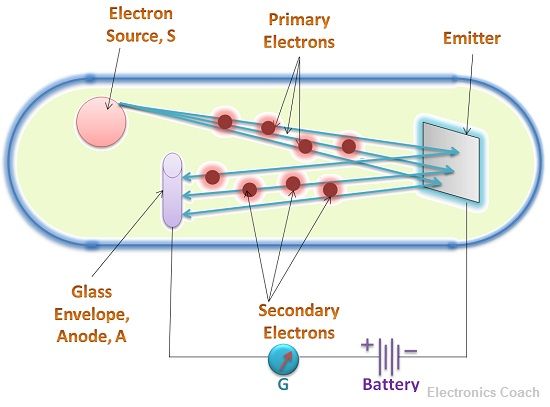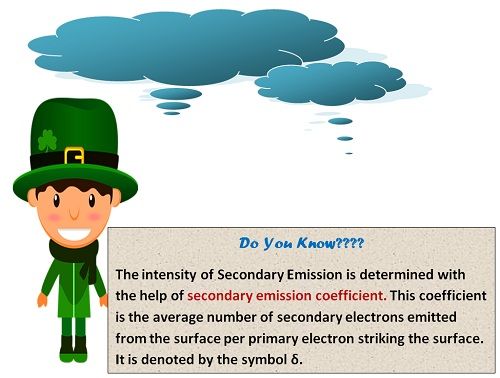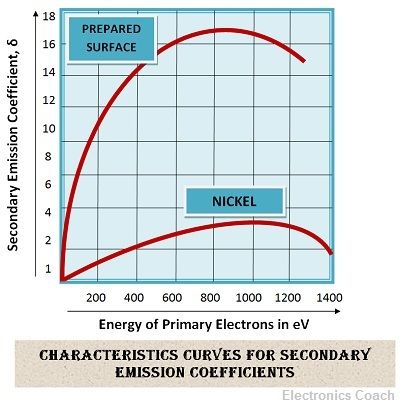Definition: Secondary Electron Emission is the phenomenon in which the primary electrons strikes the free electrons in the metal and impart their energy to them so that they can leave the metal surface. The electrons emitted by this process are called secondary electrons. And this process is called Secondary emission.
Visualization of Secondary electron Emission
Consider an electron source and an emitter made of metal is placed inside the evacuated tube filled with inert gases. It needs to be filled with inert gases or vacuum. This is because if the metal reacts with atmospheric gases then it may lead to rusting of metal and it will get deteriorated.
Here S is the electron source, and A is the glass anode which is used for collecting the emitted secondary electrons. The current in the outer circuit flows due to the emission of the secondary electron from the emitter.

Thus, inert gases do not react with the metal, and thus it will be isolated from atmospheric conditions. The electron source which is placed inside the evacuated tube emits electrons. The metal surface consists of free electrons, but they can move freely only inside the metal. They cannot come out of the surface.
The electrons emitted by the primary electronic source is called the primary electron. These primary electrons possess high energy. They strike the free electrons inside the metal with this high energy. After striking the free electrons, the velocity of the primary electrons will be lowered. Their energy will also start to diminish.
The free electrons will be imparted by the energy provided by primary electrons. Thus, their velocity will start increasing. The increase in their velocity leads to increase in their kinetic energy. Due to this high kinetic energy, now these free electrons of the metal will start knocking out of the metal surface.
These electrons are termed as secondary electrons. The emission of these electrons is termed as secondary electron emission.
Factors on which Secondary Electron Emission depends
- Count of Primary Electrons: The higher the count of primary electrons the higher will be the intensity of secondary electrons emitted. Each primary electrons when bombard with free electrons in the metal it imparts its kinetic energy to them.
Then, these secondary electrons will knock out from the surface of the metal. For a single primary electron, two or more secondary electrons are emitted. Thus, higher the number of primary electrons higher will be the number of secondary electrons.
Thus, the rate of emission of secondary electrons can be increased by increasing the number of the primary electron.
- Energy of Primary Electrons: If the energy of primary electrons is higher then we may achieve significant secondary emission. This is because some of the electrons in the metal are tightly bonded to the nucleus of the atom, while some of them are loosely bonded to the nucleus of the atom.
These are valence shell electrons. By providing the significant amount of energy to these electrons, they can break the covalent bond and becomes free.
In this stage also they are free but do not have sufficient energy to knock out or leave the surface of the metal. Thus, at this point, if they are bombarded with high energy electrons then they can also leave the surface of the metal and becomes free and contribute to the process of conduction.
- Incident angle of Primary Electron: The angle of incidence of primary electrons is also crucial for the process of secondary emission because on appropriate striking only the rate of secondary emission will be higher.
At this point, the generation of secondary electrons will be more.
- Characteristics of Emitter: The characteristics of the emitter is also crucial for the process of emission. The process of secondary emission depends on the work function of the metal.
The lower the value of work function the lower will be the energy required by it for the process of emission. Thus, the metal with lower work function is required for the process of secondary electron emission.
- Surface Area of Emitter: The surface area of the emitter is also vital for the emission of electrons. This is because more the surface area more will be the electron emission. As a consequence of this, the emission intensity will increase proportionately with the increase in the surface area.
Understanding Secondary Electron emission with the help of analogy
Consider an example of a billiard ball, in that when one ball with high speed and high energy is stricken then it will strike the another ball and that will also start moving. The picture behind the scene is the energy of the fast moving ball is imparted to the ball which is at rest, and thus, the ball which is at rest also starts moving.
Similar is the condition with secondary electron emission. In this primary electrons have imparted their energy to the secondary electron when they collide with the secondary electron.
Variation of Secondary Emission Coefficient with energy of Primary electrons

The graph below depicts the variation of secondary emission coefficient with the energy of Primary electrons for the prepared surface as well as for Nickel. The values of secondary emission coefficient also depend upon the velocity of primary electrons and the nature of the metal.
For most of the metal the value of secondary emission coefficient is between 1 to 2 but for metal which possesses low work function such as alkali metals, the emission coefficient value is between 10 to 15.

Application of Secondary Electron Emission
The secondary electron emission is crucial in various electronic devices and circuits. If you want to understand its utility, consider the significance of image intensifier circuits. Any image which is blurred can be intensified with it. An intensifier utilizes the weak current and generates a strong current signal.
Such image intensifier circuits work on the principle of secondary electron emission. Besides, devices such as dynatron oscillator, radar’s storage tube, photomultiplier, picture tubes in CRT etc. utilize the principle of secondary electron emission to achieve the desired purpose.
Leave a Reply